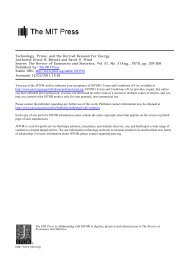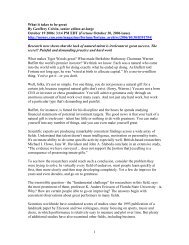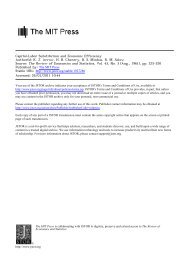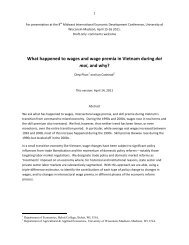Status of Wisconsin Agriculture 2010 - Agricultural & Applied ...
Status of Wisconsin Agriculture 2010 - Agricultural & Applied ...
Status of Wisconsin Agriculture 2010 - Agricultural & Applied ...
Create successful ePaper yourself
Turn your PDF publications into a flip-book with our unique Google optimized e-Paper software.
Projected <strong>Wisconsin</strong> Dairy Farm Assets and Debt, By Sales Class, December 31, 2009, $ Million<br />
Assets Debt Equity<br />
Sales Class 2009<br />
Change<br />
from 2008 2009<br />
Change<br />
from 2008 2009<br />
Change<br />
from 2008<br />
$1,000,000+ 3,766 (461) 1,269 105 2,497 (566)<br />
$500,000 - 999,999 3,068 (290) 672 51 2,396 (341)<br />
$250,000 - 499,999 5,327 (368) 722 60 4,605 (428)<br />
$100,000 - 249,999 5,443 (369) 560 29 4,883 (399)<br />
< $100,000 1,663 (103) 131 0 1,502 (78)<br />
Total 19,267 (1,566) 3,384 245 15,884 (1,810)<br />
Source: Projected by authors.<br />
adds up to a total estimated loss in<br />
dairy herd value <strong>of</strong> $1.2 billion. In<br />
allocating this loss across dairy farm<br />
size categories, we assumed equal<br />
cow and heifer values. This may not<br />
be a valid assumption, but we had<br />
no means <strong>of</strong> differentiating cow and<br />
heifer value by herd size.<br />
We estimated the loss in the value <strong>of</strong><br />
<strong>Wisconsin</strong> dairy farm land and<br />
buildings to be 3 percent in 2009,<br />
which corresponds to the January-<br />
July 2009 change in <strong>Wisconsin</strong><br />
farmland value reported by USDA-<br />
NASS and the change in “good”<br />
<strong>Wisconsin</strong> farmland from October 1,<br />
2008 to October 1, 2009 reported by<br />
the Federal Reserve Bank <strong>of</strong><br />
Chicago. We applied this percentage<br />
equally across dairy farm size categories.<br />
The total estimated reduction<br />
in land value for all <strong>Wisconsin</strong> dairy<br />
farms was $390 million.<br />
We have no basis for estimating<br />
losses associated with the sale <strong>of</strong><br />
assets to cover dairy farm operating<br />
losses. Instead, we crudely estimated<br />
operating losses and then assumed<br />
that these were <strong>of</strong>fset entirely by<br />
borrowed funds. This was clearly<br />
not the case, but the effect on dairy<br />
farm equity is the same whether<br />
assets were sold or money borrowed<br />
to cover losses.<br />
While it is impossible to measure<br />
the cash flow deficits incurred on<br />
<strong>Wisconsin</strong> dairy farms in 2009, we<br />
do have imperfect measures <strong>of</strong> gross<br />
and net cash income. We used the<br />
<strong>Wisconsin</strong> All-Milk price applied to<br />
monthly milk production as our<br />
measure <strong>of</strong> gross dairy income and<br />
added to that an estimated $240 million<br />
in MILC payments for the year.<br />
We used USDA-ERS estimated cash<br />
operating costs as our measure <strong>of</strong><br />
cash expenses. Subtracting cash<br />
costs from cash receipts yielded an<br />
estimate <strong>of</strong> total 2009 cash flow <strong>of</strong><br />
negative $245 million. This loss was<br />
allocated across farm size categories<br />
in proportion to their percent <strong>of</strong> the<br />
total livestock income in 2008.<br />
The estimated total value <strong>of</strong> assets<br />
held by dairy farms dropped about<br />
$1.6 billion in 2009. Debt, which is<br />
actually a combination <strong>of</strong> asset liquidation<br />
and borrowing to <strong>of</strong>fset<br />
negative cash flow, rose by an estimated<br />
$245 million. The net effect is<br />
an estimated $1.8 billion drop in<br />
equity for all <strong>Wisconsin</strong> dairies.<br />
The reduction in assets and equity<br />
are distributed somewhat uniformly<br />
across the four size classes <strong>of</strong> dairies<br />
with sales in excess <strong>of</strong> $100,000.<br />
However, the bulk <strong>of</strong> new borrowing<br />
was done by the largest farms.<br />
The overall debt-to-asset position <strong>of</strong><br />
all <strong>Wisconsin</strong> dairies rose from<br />
around 0.15 in 2008 to roughly 0.18<br />
in 2009. This indicates the weakened<br />
financial position <strong>of</strong> the <strong>Wisconsin</strong><br />
dairy industry. Nonetheless, a<br />
6 STATUS OF WISCONSIN AGRICULTURE <strong>2010</strong>—THE WISCONSIN FARM ECONOMY<br />
debt-to-asset position <strong>of</strong> less than<br />
0.20 still represents a sound financial<br />
position overall, despite some<br />
serious problems at the individual<br />
farm level.<br />
The largest dairy farms are likely to<br />
present some challenges for agricultural<br />
lenders in <strong>2010</strong>. These dairies<br />
are already heavy users <strong>of</strong> credit.<br />
They had 27 cents <strong>of</strong> debt per $1 <strong>of</strong><br />
assets in 2008 and by 2009 they had<br />
about 34 cents <strong>of</strong> debt per dollar <strong>of</strong><br />
assets. This elevated debt-to-asset<br />
position will be a concern to lenders<br />
who have to ensure that loan balances<br />
do not become too large relative<br />
to the value <strong>of</strong> collateral such as<br />
cows and farm real estate.<br />
While we believe it is important to<br />
provide a ballpark estimate <strong>of</strong> the<br />
loss in equity in the <strong>Wisconsin</strong> dairy<br />
farm sector due to low milk prices in<br />
2009, we must emphasize that this<br />
estimate is tentative. We made<br />
numerous assumptions to derive the<br />
components <strong>of</strong> equity loss, and the<br />
validity <strong>of</strong> many <strong>of</strong> these assumptions<br />
cannot be easily verified. Some<br />
assets, like cows and heifers, could<br />
regain value quickly with a strong<br />
rebound in milk prices. The value <strong>of</strong><br />
other assets, such as land, depend<br />
more on conditions outside <strong>of</strong> dairying<br />
than on milk prices. And it is<br />
impossible to accurately forecast<br />
when added debt will be repaid or<br />
discharged or when farmers will<br />
replace assets sold to cover losses.







